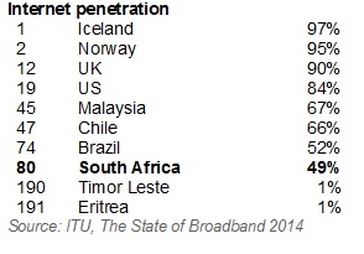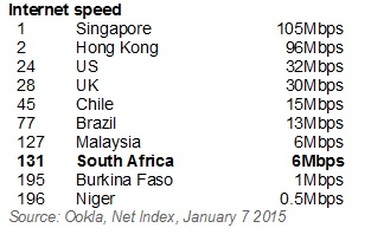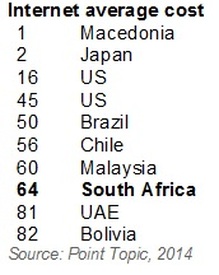If South Africa is to boost economic growth it must bring fast internet to more entrepreneurs. Doing so will help power thousands of small businesses.
For too long the country has been slow in improving access to fast, affordable always-on internet. A recently launched government broadband policy aims to fix this, but some remain skeptical.
Access to the internet today is not only vital but big money. A 2012 report by the Boston Consulting Group predicts that by next year the internet economy in G20 members will be worth $4.2 trillion (at present it contributes about 2% each to South Africa and Brazil’s economies and 8% in Japan and the UK).
In the same report, a survey of 15,000 small firms revealed that those with high internet usage record sales growth of up to 22% more than those firms with little or no use of the internet.

Adoption poor
However, internet penetration in South Africa remains low compared to other emerging economies (see table, left). Much of this is down to the government’s poor internet policies, as well as costly access to the web (it’s expensive in Malaysia and Brazil too).
Despite this South Africa last year gained a few levels in the UN’s global broadband rankings for internet penetration, climbing to 80th out of 190 countries, up from 92nd (41%) in 2013.

Too slow, expensive
The country’s main internet challenges are download speeds and high usage costs, which remain out of synch with many other emerging economies.
For example, Ookla’s Net Index, which compares and ranks consumer download speeds, reveals that speeds in Brazil and Chile are double those in South Africa (see table, right).
There is some light at the end of the tunnel though. MyBroadband, a South African website, reported this week that Telkom (which has a near monopoly in the fixed broadband market) plans to double speeds for its entry-level broadband packages to 4Mps. This is encouraging.
Costs however remain a grave concern. They may have come down since the landing of additional undersea cables in 2009, but a lack of investment in networks on land persists, while demand for radio spectrum builds with mobile broadband and wireless having taken off. This keeps subscription and usage costs high.

Despite this, broadband researchers Point Topic’s broadband tariff country scorecard for 2014 shows that South Africa performs well when it comes to entry-level broadband pricing. However, it does not rank well on average broadband tariffs (see table, left).
South Africa comes 18th out of 82 countries for entry-level broadband pricing, but on average pricing, South Africa ranks back in 64th.
The good news however is that over the past five years, fixed broadband prices as a share of gross national income (GNI) per capita have dropped by 65%. So things are set to get better, sometime soon.
Cellular muddle
With smartphones set to account for four out of five connections worldwide by 2016, according to the Boston Consulting Group, South Africa must provide more spectrum to mobile broadband.
But the government’s delay in getting digital television migration underway (the ITU’s deadline is June 17 to switch to a digital broadcasting signal), is holding things back.
A lack of competition in the local cellphone market is also keeping mobile broadband prices high, says South Africa’s Internet Services Providers’ Association. It’s hoped that the publication by the communications regulator Icasa in November last year of a final International Mobile Telephony (IMT) roadmap towards a competitive telecommunications industry will bring prices down.
Government plan
Meanwhile, the South African government, like several emerging economies has a plan to address its internet challenges.
Dubbed South Africa Connect, the policy targets an average download speed of 100Mbps by 2030, with an average user experience speed of 5Mbps by next year, available to 50% of the population.
The plan says delays in rolling out more broadband fiber can be addressed by getting the communications department and Icasa to coordinate the building of civil works and help streamline the process of wayleaves.
Co-building of networks will be used to bring down costs and reduce duplication to under-serviced areas, while incentive programs will help stimulate demand and will include a dedicated ICT entrepreneurship fund among others.
The UN has commended the plan calling it an “excellent example” of a policy that focuses on both supply-side (such as investments in broadband networks) and demand-side (through expanding ICT education) considerations.
But Ayesha Dawood, a digital media and technology lawyer, says the policy fails to explain how the country will achieve an average user experience of 5Mbps by next year or detail what the cost of this access will be for the average person.
Brazilian lesson
Brazil’s broadband challenges show that no plan is without problems. Its National Broadband Plan (Plano Nacional de Banda Larga) reveals the challenges that face governments in getting private-sector players to offer more affordable internet.
Of recent critics have bashed the plan, launched in 2006 and set to run until the end of last year, saying the private sector hasn’t done more to punt cheaper packages inscribed in the plan. Until September last year, cheaper packages made up just 8% of fixed broadband and 0.6% of mobile broadband connections.
Consumer groups have also been critical of the cheaper packages, saying operators hide them on their websites and that many come with bandwidth caps that slow the download speed in no time.
Internet access is improving in South Africa, as it is in many other emerging economies. The South African government must take internet access as seriously as any other basic service, like water, electricity, and waste collection. Or be left behind.
Reflecting on the challenges and strides made in expanding internet access in South Africa and Brazil, it’s clear that the journey towards digital inclusivity is ongoing. With the advent of applications like GB Whatsapp Apk, which offer enhanced communication features, the demand for reliable and fast internet has never been more pressing.
As they say, the proof is in the pudding, because for all words, such as those of South Africa Connect, which encourage average download speeds and enlarge the coverage area, the real impact of the nation will be held in detail. But these numbers themselves are still secondary; it is the quality access that was and is important.
This can be driven by ensuring the reliability and affordability of the packages to be attractive across society. More recent trends are also showing a positive increase in investment concerning both mobile and fixed broadband infrastructure. The affordability problem, however, still exists in rural areas and underserved markets.
From Brazil’s experience, one can learn valuable lessons, especially concerning public-private partnerships and giving an impetus to the private sector so that they might work towards providing cheap yet widely available internet packages. The National Broadband Plan (Plano Nacional de Banda Larga) insists on the power of public-private partnerships in achieving national connectivity goals.
Although such obstacles encountered were the restricted offering of more affordable packages by Brazil, she strives to make sure that the internet is increasingly more accessible. The focus now should be on the fit for services that can be offered to all Brazilians, most especially in remote and economically challenged regions.
In the future, the countries in question may learn from their experience about how to spur innovation and inclusion in digital strategies. They should include community-driven solutions, enhanced digital literacy, and investment in local content. The regulatory space would, again, have to ensure competition and innovation. Entry barriers for new entrants would have to be lowered, and most importantly, costs to the consumers have to decline.
As the digital frontier is further explored, the focus must be on how the contours of affordable and accessible internet can be provided, and the same made to work for the people. All this will lead to positive economic growth but also benefit and empower individuals and communities to equally participate in the faster-growing digital economy.
It has been quite a struggle so far on the path of attaining digital inclusivity, but with firm commitment and collaborative efforts, South Africa and Brazil can meet the challenges head-on to take full advantage of what the digital age has to offer.

Hi, I’m Sophie. As a digital creator and avid enthusiast in Business, Marketing, Finance, Tech, and News, I’m dedicated to delivering rich and engaging insights.
If you’re curious or have thoughts to share, let’s connect!
Contact: sophiekotecki@gmail.com


